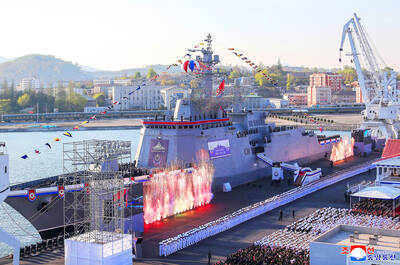One of the most intriguing mysteries in French history will be put to rest today when the heart of Louis XVII, child heir to the throne, is buried 209 years after his death in the royal crypt outside Paris.
European royals are expected to attend the funeral at the Saint-Denis basilica north of Paris, when the tiny organ kept in a crystal vase will be laid to rest near the remains of his parents, Louis XVI and Marie-Antoinette.
Louis-Charles, the so-called "lost dauphin" who would have reigned as Louis XVII, died at the age of 10 on June 8, 1795, in the French capital's Temple prison, with tuberculosis the official cause.
But his death has been the source of rumors and speculation for more than two centuries, with historians musing about the would-be king's fate until DNA tests proved the heart belonged to a Hapsburg, like Marie-Antoinette.
It's no small wonder that the death led to controversy: Louis XVII's heart was cut from his body, preserved, stolen, recovered and passed around for centuries before finding its way back to France.
Louis XVII was imprisoned with his parents and his sister in 1792 during the French Revolution. Once his parents were sent to the guillotine, Louis and his sister were separated, with the heir confined to a cramped, windowless cell.
Upon his death, the body of the child was ditched in a mass grave, but the doctor who performed the autopsy first cut out his heart and kept it in an alcohol-filled vase on his bookshelves.
He boasted of his possession to one of his students, who swiped the prize. Years later, after the thief died of tuberculosis himself, his widow returned the heart to the doctor.
The physician tried for many years to return the heart to members of the Bourbon family but was thwarted by royal squabbles. Louis XVII's remains finally found their way to the Spanish Bourbons, and eventually back to France.
Some historians and conspiracy theorists have seized on the amazing journey of the heart to argue that maybe it did not belong to Louis XVII after all, suggesting that instead of dying in prison, he had escaped or been spirited out of France to safety, and that the heart belonged to another child.
In the 19th century, several pretenders to the throne surfaced, including a German clockmaker named Karl Wilhelm Naundorff. Although he never claimed it himself, many thought US naturalist John James Audubon was the long-lost heir.
In 2000, scientists conducted DNA tests to put the rumors to rest. Result: the heart indeed belonged to a descendant of Marie-Antoinette.
Those who wanted to keep the "lost dauphin" myth alive argued that the heart could belong to Louis-Xavier-Joseph, Louis XVII's older brother who died in 1789.
But the heart of the older brother had been properly embalmed according to royal custom, while the one that had been examined -- that of Louis XVII -- had not. For historians, the debate was over.
"This is a way to give this child-martyr, who passed away in tragic circumstances and around whom mystery swirled for more than 200 years, a proper death," said Charles-Emmanuel de Bourbon-Parme, one of Louis XVII's relatives.
On Monday, the urn containing the heart -- which has been on display for 20 years at the Saint-Denis basilica -- will be transported to the Saint Germain l'Auxerrois church near the Louvre, once the royal parish, for a requiem mass.
Some 500 VIPs are expected to attend today's funeral mass at Saint-Denis, followed by the burial. Avid royal watchers not on the guest list can watch the ceremonies on two big-screen televisions outside the basilica.

Archeologists in Peru on Thursday said they found the 5,000-year-old remains of a noblewoman at the sacred city of Caral, revealing the important role played by women in the oldest center of civilization in the Americas. “What has been discovered corresponds to a woman who apparently had elevated status, an elite woman,” archeologist David Palomino said. The mummy was found in Aspero, a sacred site within the city of Caral that was a garbage dump for more than 30 years until becoming an archeological site in the 1990s. Palomino said the carefully preserved remains, dating to 3,000BC, contained skin, part of the

TRUMP EFFECT: The win capped one of the most dramatic turnarounds in Canadian political history after the Conservatives had led the Liberals by more than 20 points Canadian Prime Minister Mark Carney yesterday pledged to win US President Donald Trump’s trade war after winning Canada’s election and leading his Liberal Party to another term in power. Following a campaign dominated by Trump’s tariffs and annexation threats, Carney promised to chart “a new path forward” in a world “fundamentally changed” by a US that is newly hostile to free trade. “We are over the shock of the American betrayal, but we should never forget the lessons,” said Carney, who led the central banks of Canada and the UK before entering politics earlier this year. “We will win this trade war and

‘BODIES EVERYWHERE’: The incident occurred at a Filipino festival celebrating an anti-colonial leader, with the driver described as a ‘lone suspect’ known to police Canadian police arrested a man on Saturday after a car plowed into a street party in the western Canadian city of Vancouver, killing a number of people. Authorities said the incident happened shortly after 8pm in Vancouver’s Sunset on Fraser neighborhood as members of the Filipino community gathered to celebrate Lapu Lapu Day. The festival, which commemorates a Filipino anti-colonial leader from the 16th century, falls this year on the weekend before Canada’s election. A 30-year-old local man was arrested at the scene, Vancouver police wrote on X. The driver was a “lone suspect” known to police, a police spokesperson told journalists at the

North Korean leader Kim Jong-un has unveiled a new naval destroyer, claiming it as a significant advancement toward his goal of expanding the operational range and preemptive strike capabilities of his nuclear-armed military, state media said yesterday. North Korea’s state-run Korean Central News Agency (KCNA) said Kim attended the launching ceremony for the 5,000-tonne warship on Friday at the western port of Nampo. Kim framed the arms buildup as a response to perceived threats from the US and its allies in Asia, who have been expanding joint military exercises amid rising tensions over the North’s nuclear program. He added that the acquisition